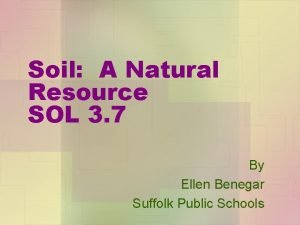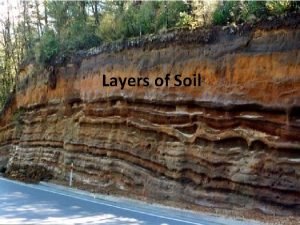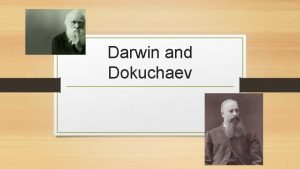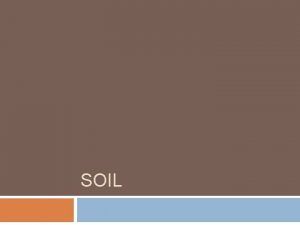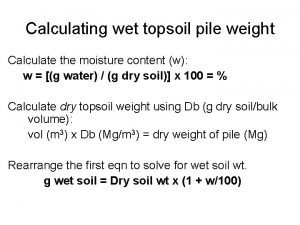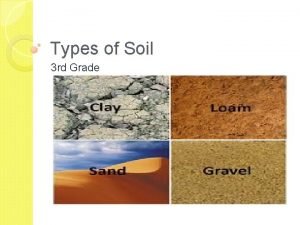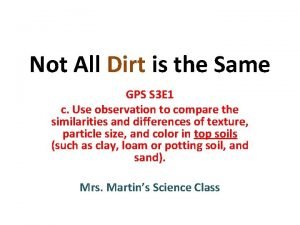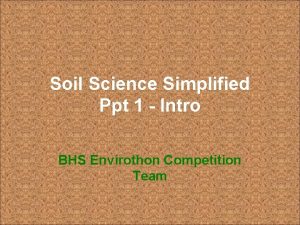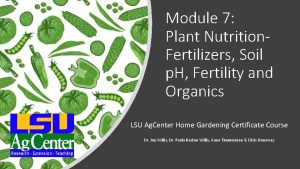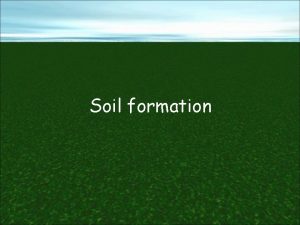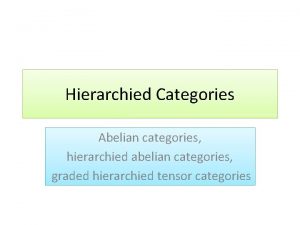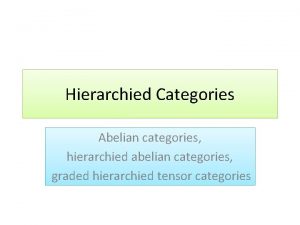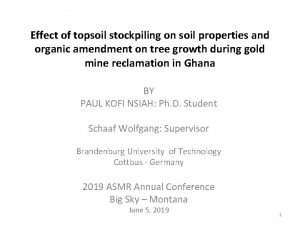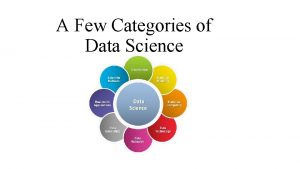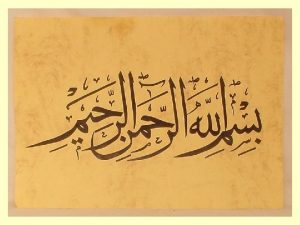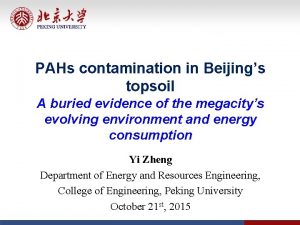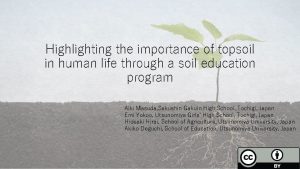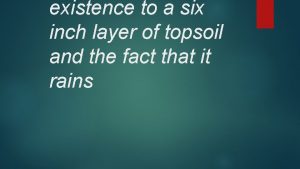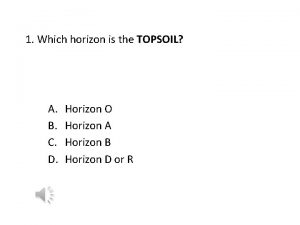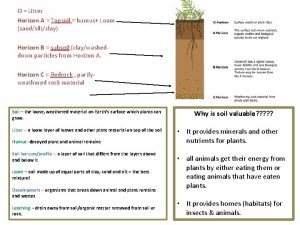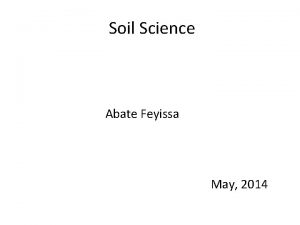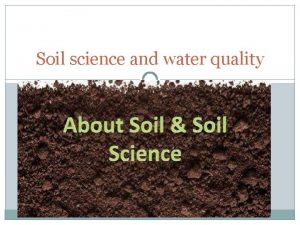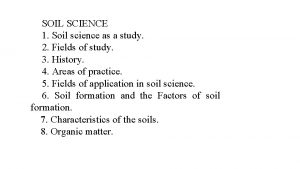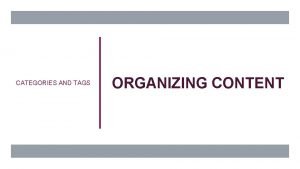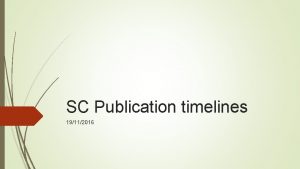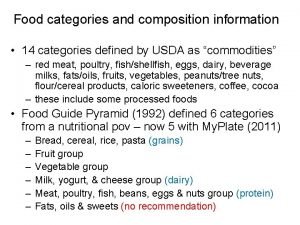Soil Science Soil Categories Topsoil The upper most






















- Slides: 22

Soil Science

Soil Categories • Topsoil • The upper most layer found in the soil profile. • Contains living and non-living material. • Animals, bacteria, plants, minerals, soil particles and organic matter. • Subsoil • Second layer found in the soil profile. • Contains much of the same material as topsoil but lacks the organic matter found in the topsoil. • Parent Material • Last layer found in the soil profile. • Made of different rock or plant formations • Limestone, Sandstone, Garnet, and Peat

Soil Formation • Soils are formed from the weathering of the parent materials. • There are two types of weathering that affects soils. • Physical Weathering • Parent material is directly exposed to the weathering affects of the atmosphere. • Water, Ice, Snow, Wind, Waves and Gravity • Chemical Weathering • Effects of atmospheric chemicals or biologically produced chemicals on the parent material.

Soil Makeup • Soil is made up of four major components. • • Sand Silt Clay Minerals

Soil Makeup • Sand • • Largest of the soil components. Range in size of 2. 0 to. 05 mm. Drains rapidly. Course in texture.

Soil Makeup • Silt • Second smallest of the soil components. • Range in size from. 063 to. 002 mm. • Can be a soil, a suspended sediment in surface water, or found on the bottom of a body of water. • Moderate drainage.

Soil Makeup • Clay • Smallest of the soil components. • Formed from chemical weathering of other soil components. • Drains very slowly.

Soil Makeup • Minerals • There are 16 nutrients that are essential for plant growth and reproduction that are found in soil. • Carbon, Hydrogen, Oxygen, Nitrogen, Phosphorus, Potassium, Sulfur, Calcium, Iron, Magnesium, Boron, Manganese, Copper, Zinc, Molybdenum, and Chlorine.

Soil Ecosystem • Relationship between the living and nonliving material found in the soil. • An example of this can be found in the Nitrogen cycle

Land Use Classification • Agricultural land can be classified as eight different land capability classes, which determines the final three land use classes. • The three land use classes are: • Row Crop – used to produce many different agriculture products • Pasture – used for the production of grazing animals and forage production • Forest – used for the production of trees and wildlife habitat.

Land Capability Classes • The eight land capability classes allow for the classification of the land their end use. • Row Crops • • Class I – used for row crops with few limitations Class II – used for row crops with some limitations Class III – used for row crops with many limitations Class IV – used for row crops with major limitations

Land Capability Classes • The eight land capability classes allow for the classification of the land their end use. • Pasture • Class V – areas that are level, but subject to flooding, Used for pasture, grazing • Class VI – Limitations prevent row crops, used for pasture

Land Capability Classes • The eight land capability classes allow for the classification of the land their end use. • Forests/Wildlife • Class VII – these soils have severe limitations, used forests and wildlife. • Class VIII – these soils have severe limitations used only forests and wildlife.

Factors that affect Land Capability • There are seven factors that affect the land capability class of a given area. • Each of these factors places limitations on the areas for it’s end use • • Slope Topsoil Thickness Erosion Topsoil Texture Permeability of the Subsoil Drainage Effective Depth

Factors that affect Land Capability • Slope • The measured amount of rise or fall on a piece of land over a given distance. • Slope is measured over a distance of 25’, 50’ or 100’ and is expressed in percent. • Categories of slope Land Use Category • • • Nearly Level Very Gentle Sloping Strongly Sloping Steep 0 -2% 2 -5% 5 -8% 8 -12% 12 -17% Over 17% Class III Class IV Class VII

Factors that affect Land Capability • Topsoil Thickness • is the measured amount of topsoil found on the site. It can be found by measuring down to the color or texture change. • Categories of Topsoil Thickness Land Use • • • Extremely Thick Very Thick Moderate Thin Over 40” Class III 20 to 40” 10 to 20” 5 to 10” Less than 5” Class II

Factors that affect Land Capability • Erosion • The removal of soil by natural or man made means • Erosion is expressed as a percent of the original topsoil which has eroded. Original topsoil thickness Measured topsoil thickness Eroded topsoil = 3” 12” 9” 3” of eroded topsoil ) 12” of original topsoil = 25% erosion

Factors that affect Land Capability • Erosion • Categories of Erosion • None to Slight – Less than 25% eroded • Moderate – 25 to 75% eroded • Severe – Over 75% eroded Land Use Class III

Factors that affect Land Capability • Topsoil Texture • Determined by the size of the soil particles in the topsoil. • Fine - smooth and sticky when wet, particles feel fine as flour. When balled in the palm of your hand, it holds the shape and shows finger marks, a long ribbon of soil can be formed by rubbing the soil between the thumb and fore finger. • Medium – medium texture soil is a mixture of sand, silt, and clay particles. It is between fine and coarse. The ball will show some finger marks and hold its shape. A short thick ribbon can be formed. • Coarse – coarse textured soil are made up of mostly sand particles. Sand feels gritty and particles are large enough to be easily seen. The ball breaks in your hand almost no ribbon can be formed. • All Topsoil Texture class are land use class I.

Factors that affect Land Capability • Drainage • Refers to the surface ad internal drainage. The best clue to soil drainage is color. • The color of most subsoils is determined by the amount of iron compound. • When the soil is aerated, the iron reacts with the oxygen giving the soil a yellow or red color. In soils that are not well aerated the soils will have a gray color or mottled with gray. • The more gray mottles found in the soil profile the slower the drainage.

Factors that affect Land Capability • Drainage • Categories of Drainage Land Use • Excessively Drained – Course texture, sandy material • • • continues for a depth of 40” Class III Well-drained – No gray mottles in top 30” Class I Moderately well-drained – No gray mottles in top 20” Class II Somewhat poorly drained – No gray mottles in top 10” Class III Poorly Drained – Gray matrix or gray mottles found in top 10”. Soil may be gray completely to the surface. Class IV Very wet – Surface water remains for extended periods of time. Class V

Factors that affect Land Capability • Effective Depth • The depth that plant roots can easily penetrate. Usually the combined thickness of the topsoil and subsoil, measured to the parent material. • Categories of Effective Depth Land Use • • Deep - Over 40” Moderate – 20 to 40” Shallow – 10 to 20” Very Shallow Less than 10” Class III Class IV
 What is topsoil
What is topsoil Humus topsoil subsoil bedrock
Humus topsoil subsoil bedrock Hydraulic topsoil darwin
Hydraulic topsoil darwin Soil horizon
Soil horizon Wet topsoil
Wet topsoil What is topsoil
What is topsoil Color 10282005
Color 10282005 What is your favorite subject answer?
What is your favorite subject answer? Living soil vs dead soil
Living soil vs dead soil Convergent plate boundaries
Convergent plate boundaries Cambridge upper secondary science competition
Cambridge upper secondary science competition Soil formation ppt
Soil formation ppt Dr nutrition
Dr nutrition Hình ảnh bộ gõ cơ thể búng tay
Hình ảnh bộ gõ cơ thể búng tay Frameset trong html5
Frameset trong html5 Bổ thể
Bổ thể Tỉ lệ cơ thể trẻ em
Tỉ lệ cơ thể trẻ em Chó sói
Chó sói Glasgow thang điểm
Glasgow thang điểm Hát lên người ơi alleluia
Hát lên người ơi alleluia Kể tên các môn thể thao
Kể tên các môn thể thao Thế nào là hệ số cao nhất
Thế nào là hệ số cao nhất Các châu lục và đại dương trên thế giới
Các châu lục và đại dương trên thế giới
